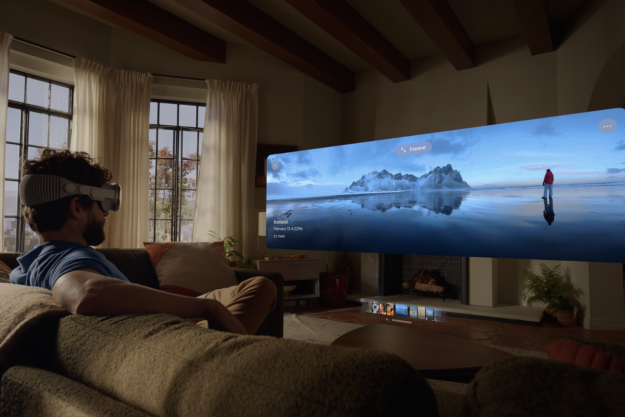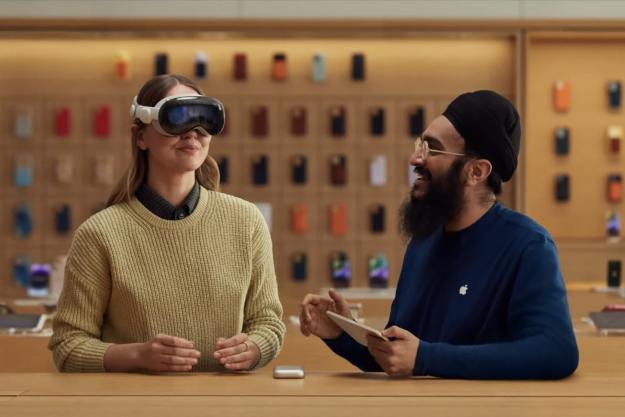When you think of Alcatel, virtual reality headsets probably aren’t the first thing that come to mind. The French electronic maker is better known by its Idol series of Android smartphones. But given VR’s moneymaking potential — some analysts project the burgeoning sector could hit $150 billion by 2020 — it’s no surprise that companies like Alcatel are jumping aboard with gusto.
Samsung’s got the Gear VR, a virtual reality peripheral for the company’s Galaxy handsets. ZTE’s got the ZTE VR. And at the IFA consumer electronics show in Berlin, Germany, Alcatel announced its take on the soon-to-be-ubiquitous VR headset: the Alcatel Vision. The hook? The Vision, unlike much of the competition, doesn’t require a smartphone.
IFA 2016: We tried Qualcomm’s VR headset, and it’s even sharper than the Vive or Rift
The Alcatel Vision is, like Microsoft’s augmented reality HoloLens headset, entirely self-contained — it looks a bit like a bulkier Oculus Rift unit, albeit one less angular in appearance. On the left side’s a touch-sensitive trackpad, and on the right are “plus” and “minus” volume adjustment buttons. On top, meanwhile, is plastic, clip-on housing for the Vision’s 3,000mAh battery that cleverly doubles as a forehead rest, and around back is a thickly padded headrest. The Vision’s by all appearances a polished package, and a thoughtfully designed one, too — Alcatel said it engineered a mask area large enough to accommodate glasses.

In terms of raw processing power, the Vision sounds quite capable. It packs two 3.8-inch, 1080p (1,920 by 1,080 pixels) AMOLED displays, one for each eye, that deliver latency below 17 milliseconds and an effective 120-degree field of view. Driving the Vision’s visuals is an octa-core processor of an unknown make and model paired with 3GB of RAM, and supplying connectivity’s an impressive melange of Bluetooth, Wi-Fi, and LTE radios. Despite all that power-sucking silicon, though, the Vision has impressive longevity — Alcatel estimates it’ll last about three hours off a charger.
Just how the Vision operates isn’t really clear yet. Alcatel coyly hinted at a “wireless” solution, which we take to mean Wi-Fi — a shaky cell connection seems like an poor match for tech that relies on a predictable, consistently high level of performance. And just as unclear is the fidelity of experiences that the Vision will deliver. Alcatel said it’s working with a number of third-party partners including video production house Jaunt VR, game publisher Magic Interactive Entertainment, and audio firm Fraunhofer, to produce VR videos, and said the headset will sport a library of over 100 VR-optimized videos and over 50 games when it launches globally.
Alcatel was coy on the Vision’s pricing, but said that it expected a price tag of between 499 and 599 euros, or about $560 to $670. That’d place it within striking distance of high-end headsets like the HTC Vive and Oculus Rift — potentially a tough sell, considering both have half a year’s head start.
Alcatel 360 Camera
Speaking of content, Alcatel’s not lying in wait. Alongside the Vision, it announced the 360 Camera, a self-descriptive virtual reality shooter that captures the sort of omnidirectional imagery viewable on the Oculus Rift, Gear VR, and Google Cardboard.
The 360 Camera isn’t exactly novel. Alcatel’s been beaten to the punch by Samsung, which released the Gear 360 — its take on the concept — earlier this year, and LG, which debuted a 360-degree video solution the form of the 360 Cam. But Alcatel’s competing more on price than merit: the 360 Camera will retail for 99 euros, or about $110, when it goes on sale around the end of the year. That’s significantly cheaper than both the 360 Cam ($200) and Gear 360 ($350).

The 360 Camera’s hardware details are rather slim pickings, unfortunately, but we do know this: there are two models, one square in shape that’s “half the size of a credit card” and the other roughly size and shape of “a coin,” which share the same dual 210-degree fisheye lenses and internals. They plug into the Micro USB port of the Alcatel Idol 4, Idol 4S, or POP 4S smartphone to shoot, and stitch together the internal cameras’ feeds in real time to produce 360-degree content.
IFA 2016: LG makes a 38-inch ultrawide monitor worth emptying your wallet for
Despite the hardware push, Alcatel’s not putting all its eggs in one basket. It’s partnered with 360-degree camera makers 360fly, ALLie Camera, Arashi Vision, and Primesom to help build out the Vision’s video library. Whether or not filmmakers will bite is another story, but given Alcatel’s wherewithal — especially in light of competition like Google’s Daydream platform — we wouldn’t be surprised to see developments in the interim.
Editors' Recommendations
- This new VR headset beats the Vision Pro in one key way and is half the price
- What’s behind customers returning their Vision Pro headsets?
- Zoom unveils immersive app for Apple’s Vision Pro headset
- There’s a bunch of bad news about Apple’s Vision Pro headset
- This $40K Vision Pro mod adds 18K gold to Apple’s headset


